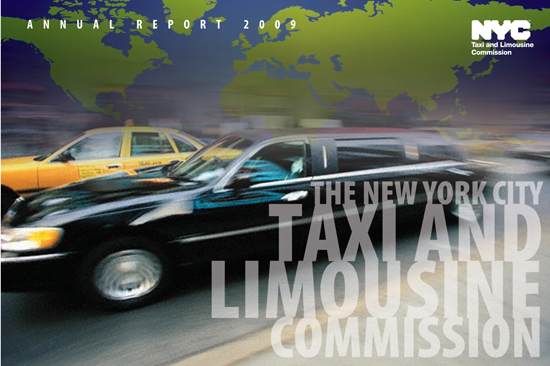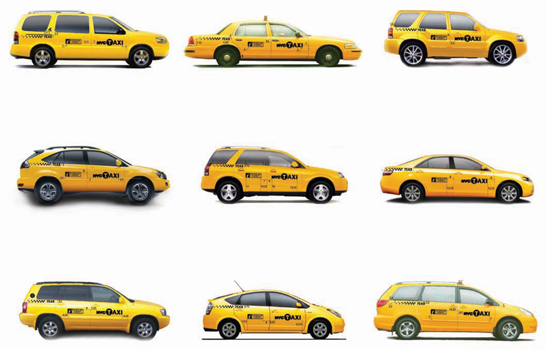|
||||||||||||||||
|
 |
David Yassky is the eleventh person to serve as Commissioner/Chairman of the New York City Taxi and Limousine Commission. He was nominated by Mayor Michael R. Bloomberg on March 12, 2010, and confirmed by unanimous vote of the New York City Council's Committee on Rules, Privileges, and Elections on March 24, 2010. Yassky’s term will expire on January 31, 2017. |
 |
The TLC’s former Commissioner/Chairman, Matthew W. Daus, was appointed in 2001 to fulfill the remainder of a term concluding January 31, 2003. In 2003, Commissioner Daus was re-appointed by Mayor Michael R. Bloomberg to serve a full term expiring January 31, 2010, and unanimously approved by the City Council’s Committee on Rules, Privileges and Elections. Prior to his appointment as Chairman, he served as General Counsel since 1998, and as Special Counsel from 1996 to 1998. |
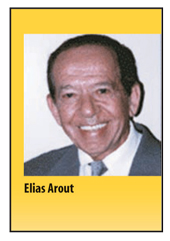 |
Re-appointed by the Mayor on the recommendation of the Staten Island delegation to the New York City Council, Commissioner Elias Arout has served on the TLC since 1988. Commissioner Arout is a past commander of the American Legion of Richmond County and a former commander of the Legion’s Five Star Post. A retired City Housing Authority officer, he was a founder and past president of the board of directors of Project Hospitality. Commissioner Arout was reappointed to a new term, which expires on January 31, 2015. |
 |
Appointed by the Mayor on the recommendation of the Queens delegation to the New York City Council in 1998, Commissioner Harry Giannoulis is a founding member of the Parkside Group, a governmental relations and public affairs consulting firm. Commissioner Giannoulis’ term expired January 31, 2001, though he may continue to serve until replaced or reappointed. |
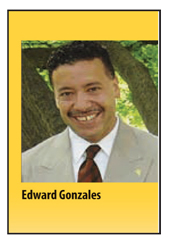 |
Appointed in September 2005 by Mayor Michael R. Bloomberg to a seven year term on the TLC, Commissioner Edward Gonzales is a mortgage specialist with Citigroup. Commissioner Gonzales’ term expires January 31, 2012 |
 |
Commissioner Jeffrey A. Kay was appointed by Mayor Michael R. Bloomberg to serve on the TLC Board in 2007. He was appointed director of the Mayor’s Office of Operations in March 2006, where he oversees publication of the Mayor’s Management Report, helps manage the daily operations of city agencies and coordinates initiatives and special projects to improve the delivery of city services. Commissioner Kay’s term expires on January 31, 2012. |
 |
Lauvienska Polanco was appointed to the Manhattan seat of the TLC Board of Commissioners in 2007. Commissioner Polanco worked briefly as a mediator for insurance defense claims, before spending some years at a personal injury law firm. After that, she joined the New York State Unified Court System, first as a Court Attorney in the Lower Civil Court, and now in an elevated role as Principal Law Clerk at the Bronx Supreme Court. Commissioner Polanco was reappointed to a new term that expires on January 31, 2015. |
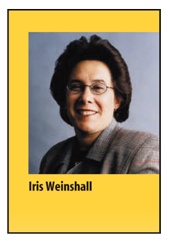 |
Appointed by Mayor Michael R. Bloomberg in 2003, Commissioner Iris Weinshall is currently Vice Chancellor for facilities planning, construction and management at CUNY. Prior to this, Commissioner Weinshall served as the Commissioner of the New York City Department of Transportation (DOT). Commissioner Weinshall also served a distinguished tenure as First Deputy Commissioner of the Department of Citywide Administrative Services. Commissioner Weinshall’s term expires on January 31, 2010. |

A TLC official (at podium) recounts the details of a taxicab driver’s heroic actions.
The TLC holds regularly scheduled publicmeetings where regulatory actions are discussed and publicly heard, base license applications are reviewed, and staff deliver presentations on new and proposed policies,pilot programs, and regulations. In 2009, the TLC promulgated seven rulemaking actions.A few examples include regulations that will enhance safety and customer service in the for-hire vehicle industry, and banning use of portable electronic devices by drivers. This report contains a calendar of the specific actions taken at Commission meetings during this past year.

The TLC Board votes at a recent public meeting.
The NewYork City TLC is responsible for the licensing and regulation of the 13,237 medallion taxicabs currently authorized to accept hails from passengers within the five boroughs of the City of New York, as well as more than 40,000 other vehicles serving the public via pre-arrangement and radio dispatch.These“for-hire vehicles” (FHVs) include community car service (or livery) vehicles, black cars, and luxury limousines with a seating capacity of up to 20 passengers. TLC also licenses and regulates paratransit vehicles (ambulettes) and commuter vans,which have a seating capacity of between nine and 20 passengers and are authorized to transport passengers within specific geographic zones via pre-arrangement. In addition to the aforementioned vehicles and drivers, the TLC licenses and regulates the businesses that manufacture, install, and repair the meters used in New York City taxicabs, brokers that assist buyers and sellers of taxicab medallions, and agents that operate taxicab medallions on behalf of owners.TLC-licensed vehicles are an essential part of the comprehensive transportation network of New York City. It is estimated that approximately 55,000 of these vehicles transport over 1.5 million passengers each day.
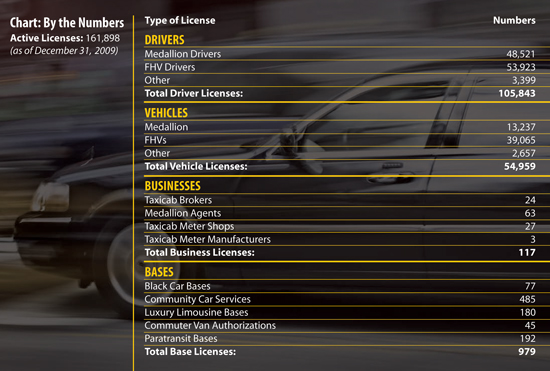
Agency Overview and Performance
TLC Web Site
The TLC’s Web site — www.nyc.gov/taxi— is a valuable centerpiece in the agency’s efforts to effectively communicate with its regulated industries. In 2009, the Web site received 2,192,434 visits. In addition to our ongoing efforts to enhance our customers’ ability to conduct business via the Internet, we have continued to update the Web site on an almost daily basis, and have added new sections, including those with detailed interactive information pertaining to the new For-Hire Vehicle Accountability Rules, vehicle inspection schedules, and the agency’s Rules Revision Project. As always, the Web site also includes nsuch highlights as fully updated Transcripts and Minutes of all public meetings and PDF versions of all informational presentations made by the members of TLC staff.

The TLC Call Center maintained a high level of answered calls in 2009 — an average of 9,200 per month. This is an increase of 3% compared to last year’s average. The average wait time that consumers and drivers must wait to speak to an agent averaged approximately three minutes. In addition to providing information to passengers and drivers, a staff member is assigned the task of conducting searches for property lost by passengers utilizing the new technology systems that are now in all taxicabs (T-PEP). T-PEP, or the Taxicab Passenger Enhancement Project, has produced technological strides leading to improvements in the TLC’s ability to locate lost property. Approximately 2,034 searches have been conducted in 2009, and due to the new technology, 384 lost items have been recovered and returned to passengers.
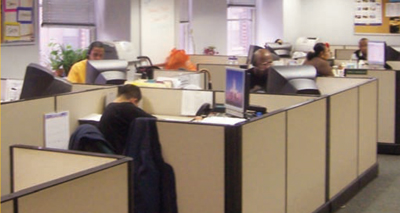
The TLC’s Consumer Call Center, hard at work.
The TLC’s Fiscal Year 2009 operated on a modified budget of $29,194,919 ($21,770,220 for Personal Services and $7,424,699 for Other Than Personal Services). The TLC had an authorized headcount of 404 for Fiscal Year 2009. The Fiscal Year 2010 budget is $29,843,230 ($22,865,565 for Personal Services and $6,977,665 for Other Than Personal Services), with an authorized headcount of 404.

Announcing Nassau County’s eligibility for reciprocity were (left to right) Nassau’s Enforcement Chief Joseph Chierchio, Nassau TLC Commissioner Roger C. Bogsted, NYC TLC Commissioner Matthew W. Daus, Westchester TLC Commissioner Barbara Z.Monohan, TLC Enforcement Chief Ronald Sobers and TLC Uniformed Services Lieutenant Martin Wattenberg.
A total of 83,545 summonses were adjudicated in 2009 by the Taxi and Limousine Commission’s Administrative Tribunal, covering 93,329 violations. Over 5,200 appeals decisions were issued and 17 new Administrative Law Judges were appointed and given extensive training. The Division introduced teleconferencing between the TLC’s Staten Island satellite office and Long Island City’s Adjudications facility, which allows respondents who received summonses to hold hearings at the Staten Island office rather than make a personal appearance at the TLC’s Long Island City location. In 2009, Adjudications conducted 1,645 consumer complaint hearings via teleconference.

TLC’s Chief Administrative Law Judge (at right) administers the Oath of Office to a new class of judges.
There was also a successful launch of videoconferencing, which adds a video component to the teleconferencing process (respondents can indicate their preference for either teleconferencing or videoconferencing). In addition, Adjudications successfully launched a Docketing Program, in conjunction with the Civil Court of the City of New York, which resulted in approximately 7,000 decisions being converted into judgments representing close to $2 million in collectible debt. Lastly, the Language Line initiative was introduced, which is a free translation service that covers 189 languages available to respondents or witnesses at hearings held at TLC Courts in Manhattan and Long Island City, as well as to anyone engaging in business at the TLC’s Licensing Division. As of January 10, 2010, 386 calls have been placed through Language Line, granting numerous individuals free over-the-phone interpretations in languages such as Spanish, Russian, Mandarin, Bengali, Cantonese, Korean, Punjabi, Urdu, and Polish.

The Licensing Division, shown here, is seeing less foot traffic due to streamlining efforts.
The TLC’s Licensing and Standards division had a particularly productive year in 2009, which included creating and implementing policies and initiatives that have further streamlined operations and improved customer service. The Division had a 5% decrease in total driver-related application volume over the 2008 levels. However, total applications processed have increased 5% from two years ago in 2007. Also, the Division continues to excel in customer service by providing our licensees with more options to process and pay for their transactions, as well as providing them with a service-friendly environment. Significant enhancements have been made to TLC’s Staten Island satellite office, including new signage, counters and flooring. In addition, Video/Teleconferencing is currently available to licensees who receive summonses and do not wish to travel to Long Island City for a hearing. The most recent technological advancement brought to the facility has been the introduction of LiveScan advanced fingerprinting and photo-imaging technology. The Licensing Division expects to complete additional upgrades to the satellite throughout 2010.

TLC’s Commissioner Matthew W. Daus, Mayor Michael R. Bloomberg, and council members at the commuter van Passenger's Bill of Rights bill signing ceremony.
Base Application Processing
The base unit had another successful year, with almost 100% of all bases renewing before their expiration date. In 2009, the Division continued the procedure begun in 2007 of emailing a representative from each City Council member’s office the list of all livery applications submitted to the TLC each month, so the Division can bring all livery applications in the for-hire vehicle industry before the Commission in a timely fashion. The base unit maintains its excellent working relationship with Enforcement and they jointly work to monitor all TLC licensed bases, making many field visits to inspect new and licensed bases.

From left to right, Staten Island Licensing Facility Director Andrew Zammitto and Staten Island Commissioner Elias Arout, welcome the addition of new electronic fingerprinting equipment, which has expedited the licensing process.
Customer Service
The Licensee Support/Customer Service Unit continues to be a major factor in helping to foster a higher level of customer relations by providing applicants and licensees with better access to information. The unit has been so successful that its headcount was increased in 2009 with customer service representatives who are the first people to greet and interface with new and existing applicants as they enter the facility. The greeters assist applicants with their questions and conduct a thorough review of the applicant’s documents and application to determine if an item is missing or a document is incomplete. They are equipped with two mobile carts with fully functional laptops and printers that allow them an increased level of access to the client’s information. In addition, some of the greeters are trilingual and bilingual, which enhances the Division’s ability to better serve its clientele. Additional customer-friendly efforts have included new signage that provides better information on the location and type of services available and the use of the language line services from the TLC’s Adjudications Division (more information about the language line service can be found in the Adjudications section).

NYC TLC’s DMV-certified inspection facility is acknowledged as the most advanced facility of its kind in the nation.
As a result of the FHV Accountability Rules passed by the Commission on April 16, 2009, the Division modified its scheduling and application processing procedures and, to better meet the needs of its clients, opened up a Licensing Office at the TLC’s Woodside, Queens facility. Bases can now request an appointment online for various types of vehicle applications in order to have their vehicle inspected prior to serving the public. The staff located at Woodside is responsible for processing various vehicle applications such as New Appointment and Vehicle Transfers for non-TC plated vehicles, and Base and Vehicle Transfers for TC plated vehicles. In addition, the Division developed a new internal scheduling program to properly split the scheduling of vehicles between the Long Island City and Woodside facilities, and modified the agency’s Web site with a new appointment request form that provides for a cleaner interface for the requesting base. Once an appointment request is submitted, the base will receive a confirmation within 48 hours of the vehicle’s appointment via fax or e-mail. In addition, a schedule of confirmed appointments is also available on the TLC’s Web site.
Driver Educational Requirements
In Spring of 2009, the TLC released a Request for Information (RFI) to enhance the current educational training program in order to further professionalize driver licensees to deliver even more exceptional services to the riding public. The goal is to improve the education system and enhance the requirements that need to be met for licensure and the continuing education process in order to develop a more professional workforce.

The new Passenger’s Bill of Rights that is displayed in all TLC-licensed livery vehicles.

In 2009, the TLC passed new rules that required this new decal to be displayed on both the rear quarter windows in livery and black car vehicles. This decal shows that the vehicle is licensed by the TLC.
The TLC’s Uniformed Services Bureau (USB) continued in its efforts to protect the public during 2009. The agency’s principal undercover enforcement initiative, “Operation Refusal,” which measures the compliance of taxicab drivers with the laws, rules and regulations that prohibit their refusal of service to the riding public under any but a select few circumstances, tested 3,665 taxicab drivers in 2009. This testing yielded a 95.28% compliance rate, an improvement of almost 2% since 2007 when the compliance rate yielded 93.80%.
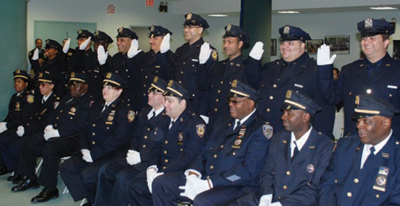
The TLC swears in another class of New York’s Proudest
.
“Operation Street Hail,” another signature undercover initiative testing for-hire drivers’ compliance with regulations requiring their services to be delivered via pre-arrangement, resulted in the issuance of 708 summonses for illegal activity in 2009.
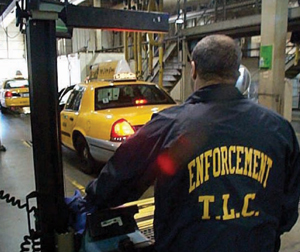
An Inspection Officer performs an emissions test on a NYC taxicab.
An undercover initiative called “Operation Secret Rider” has been successful in monitoring drivers’ delivery of customer service, ensuring that the Passenger Bill of Rights is adhered to, and that there is compliance with important elements of service — such as the option to pay for fares by credit card, riding in a clean cab and drivers not talking on a cell phone while driving. In 2009, there was a 93% compliance rate, an improvement of 1% over last year’s compliance rate of 92% —when the initiative was first introduced.

NYC TLC Commissioner Matthew W. Daus (at podium) joins Queens District Attorney Richard Brown (center) and PANYNJ Executive Director Christopher Ward in announcing the arrest of 18 airport hustlers, thanks to tougher new laws.

In addition, USB worked closely with Constituent Affairs as well as Licensing and Standards on the for-hire vehicle rules that were passed in 2009. Prior to some of the rules’ effective dates, the Unit mailed and delivered new decals to all licensed for-hire vehicle bases. In addition, the Bureau’s certified Safety and Emission’s facility, located in Woodside, Queens, began to conduct TLC and DMV safety inspections on all licensed vehicles in the FHV and Commuter Van Industry.
Lastly, to continue protecting the riding public, in 2009 the TLC passed additional rules to raise penalties for any licensed TLC driver who uses a handheld or hands-free device while driving. In 1999, the TLC was the first regulatory agency to ban the use of mobile devices by its driver licensees. However, due to new advancements in technology such as Bluetooth, additional rulemaking became necessary to overcome street enforcement challenges. Strict enforcement on the new Distracted Driver Rule package will take place throughout 2010.
Taxi of Tomorrow Project
In December of 2009, it was announced that the New York City Department of Citywide Administrative Services would be issuing, on behalf of the TLC, a Request for Proposals (RFP) for the Taxi of Tomorrow project—part of a major effort to upgrade today’s taxi fleet in order to better meet the requirements and desires of passengers, drivers, owners, and the city in general. The RFP follows several initiatives in recent years, including Taxi ’07 (a design-oriented celebration of New York’s taxicab centennial featuring an exhibition of prototypical future taxicabs), and a Request for Information (RFI) that asked the automotive industry to explain what it considers to be possible. Of course, the Taxi of Tomorrow brings together many Bloomberg Administration goals, among them increasing the number of fuel-efficient and wheelchair accessible taxicabs, as well as the enhancement of passenger comfort amenities.
The RFP will represent a new way to bring taxicabs into the market, seeking a highly qualified manufacturer with the knowledge and relevant experience to bring to reality the TLC’s and its stakeholders’ vision of what the next generation of taxicabs ought to be. That vision is a very specific one, calling for taxicabs that meet the highest safety standards; offer passengers a superior riding experience and drivers greater comfort and amenities; have an appropriate purchase price, as well as ongoing maintenance and repair costs; leave a smaller environmental footprint (lower emissions, improved fuel economy) and a smaller physical footprint (more usable interior space); accessibility for all users; and an iconic design that will come to say “New York City” to one and all.
The successful respondent to the RFP is expected to have the right to provide, exclusively, the quintessential New York City taxicab for a full ten years. This is an incentive that will no doubt create real interest and keen competition, the combination of which promises to ultimately result in a safer, cleaner, more convenient and comfortable taxicab that ideally fits the Taxi of Tomorrow designation so desired. The TLC expects to have the new taxicabs serving the riding public by the end of 2013.

